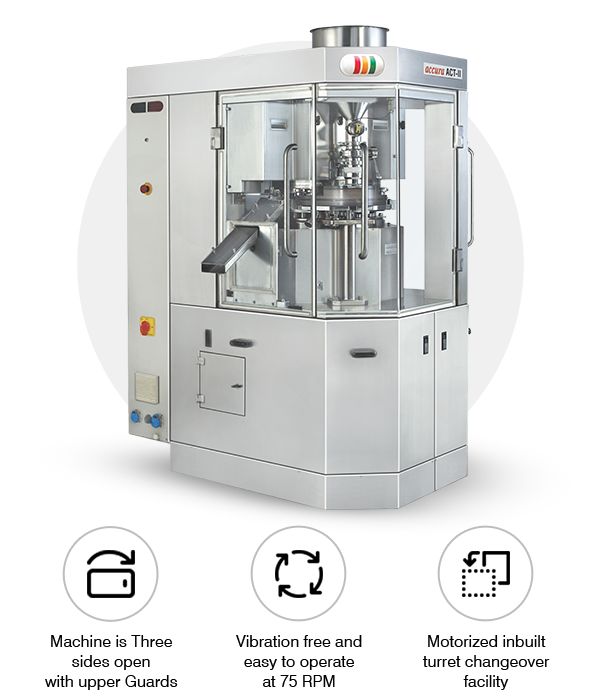Startup Rejection and Sampling in a Single Rotary Tablet Press
The purpose of this article is to explore how the startup rejection and sampling features integrated into Single Rotary Tablet Presses can significantly optimize the tablet manufacturing process. By examining their operational impact, we will highlight how these features improve product quality, reduce waste and ensure the efficient production of tablets.
Single Rotary Tablet Press Machines with Startup Rejection and Sampling for Efficient, High-Quality Tablet Production
The modern pharmaceutical industry is driven by the need for high-quality and large-volume tablet production. In this context, Single Rotary Tablet Presses play a pivotal role, providing high-speed and reliable operations for tablet manufacturing. Among the various features that improve operational efficiency and product quality, the startup rejection and sampling features stand out.
These features allow manufacturers to minimize waste, ensure consistent product quality from the beginning of the production run and optimize the manufacturing process for faster and more cost-effective tablet production. This article focuses on how these features of Single Rotary Tablet Press Machines contribute to the overall efficiency and effectiveness of tablet manufacturing.
What Role Do Startup Rejection Features Play in Optimizing Tablet Production?
In any tablet manufacturing process, consistency and precision are paramount. Startup rejection refers to the process of rejecting tablets that are produced at the beginning of the production run, typically during the startup phase. During this phase, the Single Side Rotary Tablet Press may produce tablets that do not meet quality standards due to various factors, such as inconsistent powder feeding, fluctuations in compression forces or imbalances in the machine setup.
By incorporating startup rejection features, the press automatically discards these initial tablets before they reach the packaging stage. This helps to ensure that only tablets meeting the required specifications move forward in the production line. By preventing defective or non-compliant tablets from being included in the final product batch, the startup rejection feature plays a crucial role in reducing waste and ensuring the production of consistent, high-quality tablets.
These features are essential for manufacturers who require the highest level of precision and reliability in their tablet production processes, particularly when scaling production volumes.
Read Our Article: A Comprehensive Analysis: Single Rotary Tablet Press vs. Double Rotary Tablet Press Machines
How Do Sampling Features in Single Rotary Tablet Press Machines Optimize Tablet Manufacturing?
Sampling features are another critical aspect of Single Rotary Tablet Press Machines that help to optimize the tablet manufacturing process. These features are designed to collect a sample of tablets at regular intervals during production, allowing for real-time quality control.
By taking samples during the compression process, manufacturers can perform essential tests such as weight, hardness and thickness checks. This allows for quick detection of any deviations from the desired specifications, enabling operators to make real-time adjustments to the process.
The inclusion of a sampling feature in the tablet press ensures that any changes in the production environment - such as variations in material properties or equipment wear - are identified early. This not only minimizes the risk of producing defective tablets but also helps to maintain consistent tablet quality over extended production runs.

How Do Startup Rejection and Sampling Features Contribute to Waste Reduction?
One of the key challenges in pharmaceutical manufacturing is reducing waste while maintaining high production standards. Waste can be generated when defective tablets are not identified early enough, resulting in a large batch of unusable product. Both startup rejection and sampling features are instrumental in minimizing waste.
By rejecting defective tablets early in the process through startup rejection, manufacturers prevent them from entering the production line and causing further contamination or issues. Similarly, the sampling feature ensures that any defects in tablet quality are detected early, reducing the need for larger-scale rework or disposal.
Together, these features help to minimize material waste, reduce the time spent on rework or product recalls and increase overall production efficiency. As a result, the manufacturing process becomes more cost-effective, contributing to a more sustainable and profitable operation.
Related Machine: Single Sided Rotary Tablet Press Machine
How Does the Integration of Startup Rejection and Sampling Improve Operational Efficiency?
Single-Sided Rotary Tablet Presses are designed to operate continuously and at high speeds, making efficiency a crucial factor in their success. The integration of startup rejection and sampling features directly enhances operational efficiency by automating key processes.
Without these features, operators would need to manually inspect the production output, which can be time-consuming and prone to human error. With startup rejection, the press automatically discards faulty tablets, ensuring that only acceptable tablets proceed to the next stage of production. Similarly, the sampling feature continuously monitors tablet quality, allowing for quick adjustments that keep production running smoothly.
The result is a more streamlined operation where fewer interruptions occur, production times are reduced and resources are used more effectively. This increased efficiency is essential for meeting high production demands while maintaining the highest quality standards.
Read Our Article: Single Rotary Tablet Press Machine Construction and Features
How Do Startup Rejection and Sampling Features Ensure Consistent Product Quality?
In pharmaceutical manufacturing, ensuring the quality of each tablet is non-negotiable. The Single Sided Rotary Tablet Press's startup rejection and sampling features play a crucial role in maintaining consistent tablet quality throughout the production run.
By rejecting the initial imperfect tablets, the startup rejection feature ensures that only tablets made with the correct formulation and machine settings are included in the final batch. This eliminates the risk of early-stage inconsistencies affecting the overall batch.
Moreover, the sampling feature provides a continuous feedback loop on tablet quality, enabling operators to make adjustments as needed. By checking tablet quality regularly, these features ensure that deviations are corrected before they impact the final product, ensuring that each tablet produced meets the necessary quality standards.
Single Side Rotary Tablet Press Machines with Startup Rejection and Sampling for Efficient, Consistent Tablet Production
High Speed Single Sided Rotary Tablet Presses with startup rejection and sampling features represent a significant advancement in tablet manufacturing. These features provide a robust solution for improving the efficiency, quality and consistency of tablet production, helping manufacturers meet the high standards demanded by the pharmaceutical industry.
With startup rejection, faulty tablets are identified and discarded early in the process, preventing wasted resources and ensuring that only high-quality tablets move forward. Meanwhile, sampling features provide real-time feedback, allowing for immediate adjustments to the production process and ensuring consistent tablet quality.
Together, these features contribute to a more efficient, waste-reducing and high-quality tablet manufacturing process, making Single Side Rotary Tablet Press Machines indispensable in modern pharmaceutical production.





